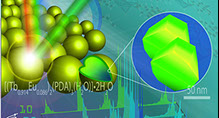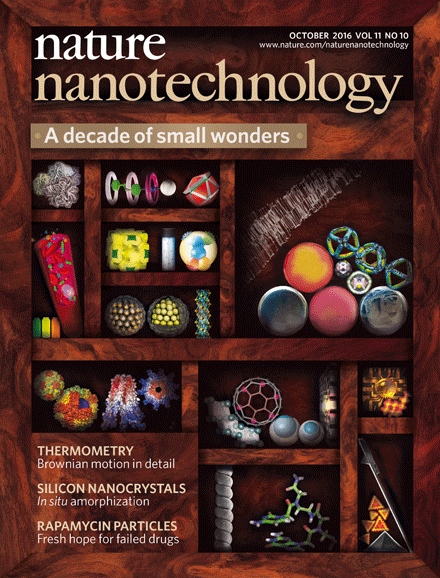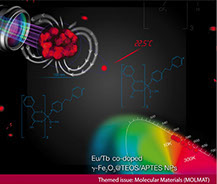


<
>
PHOTONIC HYBRIDS AND NANOMATERIALS GROUP
Aveiro-Portugal
university of aveiro
theoria poiesis praxis
physics department
ciceco
aveiro institute of materials



TEMPERATURE DETERMINATION AT THE NANOSCALE
Sensing and mapping temperature in an accurate and noninvasive way with submicrometric resolution is critical to understand numerous features of micro and nanoscale electronic and photonic devices, such as thermal transport, heat dissipation, and profiles of heat transfer and thermal reactions. Furthermore, the precise discrimination of the temperature of a living cell, especially that of a cancer cell, strongly impacts on the consciousness of its pathology and physiology and, in turn, on the optimization of therapeutic processes (e.g. in hyperthermal tumour treatment and photodynamic therapy).
submicrometric resolution is critical to understand numerous features of micro and nanoscale electronic and photonic devices, such as thermal transport, heat dissipation, and profiles of heat transfer and thermal reactions. Furthermore, the precise discrimination of the temperature of a living cell, especially that of a cancer cell, strongly impacts on the consciousness of its pathology and physiology and, in turn, on the optimization of therapeutic processes (e.g. in hyperthermal tumour treatment and photodynamic therapy).
Conventional temperature sensors are the so-called contact thermometers, in which the measurement of temperature is achieved by heat flow to an invasive probe. The contact nature of such measurements makes traditional liquid-filled and bimetallic thermometers, thermocouples and thermistors not suitable for temperature measurements of fast-moving objects or in scales below 10 micrometers. Therefore a new generation  of nanoscaled thermometers is demanded to accurately measure temperature distributions down to the nanoscale regime, where conventional methods are not able to give satisfactory results (e.g. intracellular temperature fluctuations, temperature at molecular scale, or in microcircuits and microfluids).
of nanoscaled thermometers is demanded to accurately measure temperature distributions down to the nanoscale regime, where conventional methods are not able to give satisfactory results (e.g. intracellular temperature fluctuations, temperature at molecular scale, or in microcircuits and microfluids).
RESEARCH HIGHLIGHTS
C. D. S. Brites, X. Xie, M. L. Debasu, X. Qin, J. Rocha, X. Liu, L. D. Carlos “Instantaneous Ballistic Velocity of Suspended Brownian Nanocrystals Measured by Upconversion Nanothermometry” Nature Nanotechnol., 11, 851–856 (2016)
http://dx.doi.org/10.1038/NNANO.2016.111
Brownian motion is one of the most fascinating phenomena in nature. Its conceptual implications have a profound impact in almost every field of science and even economics, from dissipative processes in thermodynamic systems gene therapy in biomedical research, artificial motors and galaxy formation to the behaviour of stock prices8. However, despite extensive experimental investigations, the basic microscopic knowledge of prototypical systems such as colloidal particles in a fluid is still far from being complete. This is particularly the case for the measurement of the particles' instantaneous velocities, elusive due to the rapid random movements on extremely short timescales. Here, we report the measurement of the instantaneous ballistic velocity of Brownian nanocrystals suspended in both aqueous and organic solvents. To achieve this, we develop a technique based on upconversion nanothermometry.
C. D. S. Brites, P. P. Lima, N. J. O. Silva, A. Millán, V. S. Amaral, F. Palacio, L. D. Carlos, “Lanthanide-based Luminescent Molecular Thermometers”, New J. Chem. 35, 1177–1183 (2011) http://dx.doi.org/10.1039/C0NJ01010C
Non-invasive accurate thermometers with high spatial resolution and operating at sub-micron scales, where the conventional methods are ineffective, are currently a very active field of research strongly stimulated in the last couple of years by the challenging demands of nanotechnology and biomedicine. This perspective offers a general overview of recent examples of accurate luminescent thermometers working at micrometric and nanometric scales, particularly those involving advanced Ln3+-based functional organic–inorganic hybrid materials.
C. D. S. Brites, P. P. Lima, N. J. O. Silva, A. Millán, V. S. Amaral, F. Palacio, L. D. Carlos, “A Luminescent Molecular Thermometer for Long-Term Absolute Temperature Measurements at the Nanoscale”, Adv. Mater. 22, 4499–4504 (2010)
http://dx.doi.org/10.1002/adma.20100178
Temperature is a fundamental thermodynamic variable, the measurement of which is crucial in countless scientific investigations and technological developments, accounting at present for 75%–80% of the sensor market throughout the world. Traditional liquid-filled and bimetallic thermometers, thermocouples, pyrometers, and thermistors are generally not suitable for temperature measurements at scales below 10 μm. This intrinsic limitation has encouraged the development of new non-contact accurate thermometers with micrometric and nanometric precision, a challenging research topic increasingly hankered for.
MADE BY PHANTOM-G, AVEIRO, PORTUGAL



